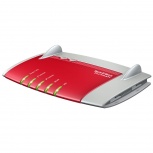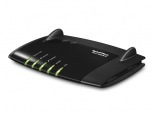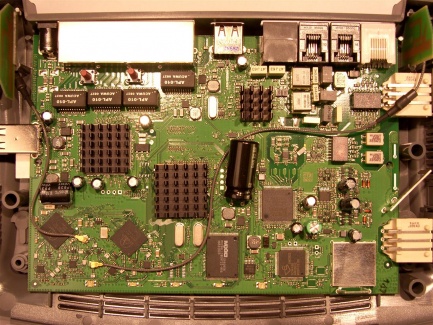FRITZ!Box Fon WLAN 7390: Unterschied zwischen den Versionen
Keine Bearbeitungszusammenfassung |
|||
| (19 dazwischenliegende Versionen derselben Benutzerin werden nicht angezeigt) | |||
| Zeile 1: | Zeile 1: | ||
<div style="margin: 0; margin-top:10px; margin-right:10px; border: 1px solid #333333; padding: 0em 1em 1em 1em; background-color:#1B1C2D; align:right;"> | |||
<br><center>[[Datei:ZD-Logo.png]]</center> | |||
<center><big><span style="color:#B5B5B5;">'''''Das Board mit Freiheiten'''''</span></big></center> | |||
<div style="margin: 0; margin-top:10px; margin-right:10px; border: 1px solid # | <font color=white></font> | ||
<br> | |||
<center | |||
< | |||
---- | ---- | ||
<div style="margin: | <br> | ||
< | <div style="margin: 0px 20px 15pt 15pt; border: 2px solid rgb(223, 223, 223); padding: 0em 1em 1em; background-color:#303140; border: 1px solid #000000;"> | ||
<br/> | |||
{{Navi-Modell-Sektion}} | |||
<br> Modell 1 AVM in rot | |||
Die FRITZ!Box Fon WLAN 7390 vereint eine bisher nicht erreichte Vielfalt in einem Gerät: VDSL- und ADSL-Unterstützung, DECT-Basisstation fürs schnurlose Telefonieren sowie WLAN N für die optimale Datenübertragung. Über den Mediaserver sind gespeicherte Filme, Musik und Bilder auch bei ausgeschaltetem Computer im gesamten Netzwerk verfügbar. Darüber hinaus kann der Online-Speicher wie eine lokale Festplatte genutzt werden. So wird die FRITZ!Box Fon WLAN 7390 zur idealen Plattform für vernetzte Anwendungen wie IP-TV, Video-on-Demand oder Mediastreaming. | [[Image:FRITZBox7390 460.jpg|156x93px|FRITZBox7390 460.jpg]] | ||
Modell 2 AVM mit Lüftungsschlitzen in rot | |||
[[Image:Avm fritzbox fon wlan 7390 freigestellt de.jpg|153x153px|Avm fritzbox fon wlan 7390 freigestellt de.jpg]] | |||
Modell 1 1&1 in schwarz | |||
[[Image:1und1 7390.jpg|152x114px|1und1 7390.jpg]] | |||
Modell 2 1&1 mit Lüftungsschlitzen in schwarz | |||
[[Image:140.jpg]] | |||
<br> Die FRITZ!Box Fon WLAN 7390 vereint eine bisher nicht erreichte Vielfalt in einem Gerät: VDSL- und ADSL-Unterstützung, DECT-Basisstation fürs schnurlose Telefonieren sowie WLAN N für die optimale Datenübertragung. Über den Mediaserver sind gespeicherte Filme, Musik und Bilder auch bei ausgeschaltetem Computer im gesamten Netzwerk verfügbar. Darüber hinaus kann der Online-Speicher wie eine lokale Festplatte genutzt werden. So wird die FRITZ!Box Fon WLAN 7390 zur idealen Plattform für vernetzte Anwendungen wie IP-TV, Video-on-Demand oder Mediastreaming. | |||
== Technische Daten == | == Technische Daten == | ||
'''CPU''': [http://www.ikanos.com/products/communications-processors/fusiv-vx180/ Ikanos Fusiv Vx180] IKF6850 @500 MHz [1]<br> '''DSL-Frontend''': Ikanos [http://ikanos.welcomm.com/lib/assets/pdfs/solutions/Vx180_IFE-6_MM_xDSL_Gateway.pdf FXS60IF1] "Analog integrated front end (IFE)"<br> '''WLAN''': | |||
#1x Atheros [http://www.atheros.com/pt/bulletins/AR9002AP-4XHGBulletin.pdf AR9220] (2 Tx, 2 Rx, 802.11a/b/g/n, dual-band 2.4 / 5GHz)<br> | #1x Atheros [http://www.atheros.com/pt/bulletins/AR9002AP-4XHGBulletin.pdf AR9220] (2 Tx, 2 Rx, 802.11a/b/g/n, dual-band 2.4 / 5GHz)<br> | ||
#1x Atheros [http://www.atheros.com/pt/bulletins/AR9002AP-4XHGBulletin.pdf AR9223] (2 Tx, 2 Rx, 802.11a/b/g/n, single-band 2.4 GHz)< | #1x Atheros [http://www.atheros.com/pt/bulletins/AR9002AP-4XHGBulletin.pdf AR9223] (2 Tx, 2 Rx, 802.11a/b/g/n, single-band 2.4 GHz)< | ||
Gleichzeitiger Betrieb im 2.4 GHz und 5 GHz-Band ist möglich.<br> '''DECT''': Sitel SC14488<br> '''FPGA''': XILINX Spartan 3 ([http://www.xilinx.com/support/documentation/data_sheets/ds312.pdf XC3S250E])<br> '''Gigabit Ethernet-Switch''': Vermutlich Atheros [http://www.atheros.com/news/AR8316_AR8121.htm AR8316] [3]<br> '''Speicher''':<br> | |||
#RAM-Speicher: 128 MB (2 * Zentel [http://www.zentel.com.tw/download/A3S12D3040ETP_v1.4_Zentel.zip A3S12D40ETP-G5] DDR1-333, 512Mbit) | #RAM-Speicher: 128 MB (2 * Zentel [http://www.zentel.com.tw/download/A3S12D3040ETP_v1.4_Zentel.zip A3S12D40ETP-G5] DDR1-333, 512Mbit) | ||
#Flashspeicher:<br> | #Flashspeicher:<br> | ||
#*16 MB (1x Macronix [http://www.mxic.com.tw/QuickPlace/hq/PageLibrary4825740B00298A3B.nsf/h_Index/DBACA1C90564EBB248257639003A563A/$File/MX29GL128Ever11-1.1.pdf MX29GL128E] 128Mbit) als Firmware-Flash | #*16 MB (1x Macronix [http://www.mxic.com.tw/QuickPlace/hq/PageLibrary4825740B00298A3B.nsf/h_Index/DBACA1C90564EBB248257639003A563A/$File/MX29GL128Ever11-1.1.pdf MX29GL128E] 128Mbit) als Firmware-Flash | ||
#*512 MB (1x ST [http://digchip.com/datasheets/parts/datasheet/456/NAND04GW3B2BN6E-pdf.php NAND04GW3B2BN6E] 4Gbit) für "Netzwerkspeicher" (NAS) | #*512 MB (1x ST [http://digchip.com/datasheets/parts/datasheet/456/NAND04GW3B2BN6E-pdf.php NAND04GW3B2BN6E] 4Gbit) für "Netzwerkspeicher" (NAS) | ||
[[Image:7390 a.JPG|434x325px|7390 a.JPG]] | |||
== Schnittstellen == | |||
#2x WLAN-Antenne (im Gehäuse) | #2x WLAN-Antenne (im Gehäuse) | ||
#2x DECT-Antenne (auf Platine) | #2x DECT-Antenne (auf Platine) | ||
| Zeile 39: | Zeile 50: | ||
#1x ISDN S0 Bus Treiber ("Ausgang") | #1x ISDN S0 Bus Treiber ("Ausgang") | ||
#4x 10 / 100 / 1000 Mbit LAN RJ45 | #4x 10 / 100 / 1000 Mbit LAN RJ45 | ||
#1x ADSL / ADSL2+ / VDSL2 | #1x ADSL / ADSL2+ / VDSL2 | ||
== | == Quellenangaben == | ||
*http://www.avm.de/de/ | |||
*http://wehavemorefun.de/fritzbox/index.php/FRITZ%21Box_Fon_WLAN_7390 | |||
*Author : hippie200 | |||
*[[GFDL]] | |||
==Wichtige Links== | |||
*[[FRITZ!Box-Familie|zurück]] | |||
== Wichtige Links == | *[[Hauptseite FRITZ!Box|Zurück zu Fritzbox]] | ||
*[[ | |||
*[[FRITZ!Box|Zurück zu Fritzbox]] | |||
*[[Hauptseite|Zurück zu Hauptseite]] | *[[Hauptseite|Zurück zu Hauptseite]] | ||
[[Category:Fritzbox]] | [[Category:Fritzbox]] | ||
Aktuelle Version vom 25. März 2012, 05:21 Uhr

| Zebradem Fritzbox Wiki >> FRITZ!Box-Modelle >> FRITZ!Box Fon WLAN 7390 | Magyar, Nederlands, Italiano, English |
| Community | Modelle | Freetz | Fritzbox Tipps & Tricks |
| FRITZ!Box-Familie | Verwandtschaft | Telekom-Derivate | Sonstige Derivate | andere Anbieter |
Modell 1 AVM in rot
Modell 2 AVM mit Lüftungsschlitzen in rot
Modell 1 1&1 in schwarz
Modell 2 1&1 mit Lüftungsschlitzen in schwarz
Die FRITZ!Box Fon WLAN 7390 vereint eine bisher nicht erreichte Vielfalt in einem Gerät: VDSL- und ADSL-Unterstützung, DECT-Basisstation fürs schnurlose Telefonieren sowie WLAN N für die optimale Datenübertragung. Über den Mediaserver sind gespeicherte Filme, Musik und Bilder auch bei ausgeschaltetem Computer im gesamten Netzwerk verfügbar. Darüber hinaus kann der Online-Speicher wie eine lokale Festplatte genutzt werden. So wird die FRITZ!Box Fon WLAN 7390 zur idealen Plattform für vernetzte Anwendungen wie IP-TV, Video-on-Demand oder Mediastreaming.
Technische Daten
CPU: Ikanos Fusiv Vx180 IKF6850 @500 MHz [1]
DSL-Frontend: Ikanos FXS60IF1 "Analog integrated front end (IFE)"
WLAN:
- 1x Atheros AR9220 (2 Tx, 2 Rx, 802.11a/b/g/n, dual-band 2.4 / 5GHz)
- 1x Atheros AR9223 (2 Tx, 2 Rx, 802.11a/b/g/n, single-band 2.4 GHz)<
Gleichzeitiger Betrieb im 2.4 GHz und 5 GHz-Band ist möglich.
DECT: Sitel SC14488
FPGA: XILINX Spartan 3 (XC3S250E)
Gigabit Ethernet-Switch: Vermutlich Atheros AR8316 [3]
Speicher:
- RAM-Speicher: 128 MB (2 * Zentel A3S12D40ETP-G5 DDR1-333, 512Mbit)
- Flashspeicher:
- 16 MB (1x Macronix MX29GL128E 128Mbit) als Firmware-Flash
- 512 MB (1x ST NAND04GW3B2BN6E 4Gbit) für "Netzwerkspeicher" (NAS)
Schnittstellen
- 2x WLAN-Antenne (im Gehäuse)
- 2x DECT-Antenne (auf Platine)
- 2x USB 2.0 (USB-Host, also auch als Printserver einsetzbar / Festplattenunterstützung)
- 2x a/b-Anschlüsse (2 TAE-Buchsen und 2 RJ11-Buchsen für analoges Telefon)
- 1x Festnetz-Eingang (Analog oder ISDN)
- 1x ISDN S0 Bus Treiber ("Ausgang")
- 4x 10 / 100 / 1000 Mbit LAN RJ45
- 1x ADSL / ADSL2+ / VDSL2
Quellenangaben
- http://www.avm.de/de/
- http://wehavemorefun.de/fritzbox/index.php/FRITZ%21Box_Fon_WLAN_7390
- Author : hippie200
- GFDL




